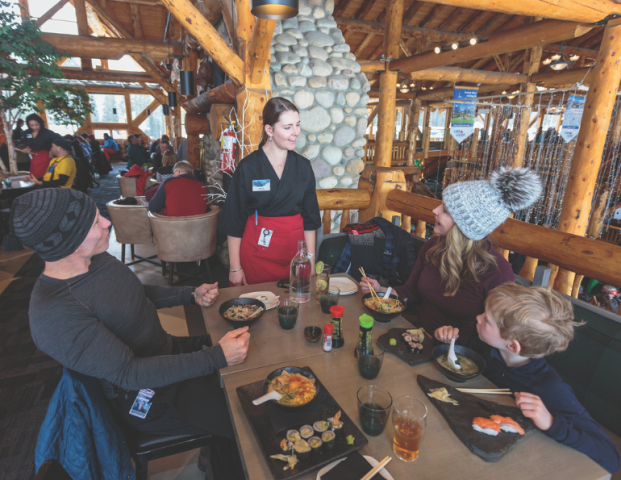Staffing issues—exacerbated during the Covid-19 pandemic—continue to affect food and beverage operations at North American ski resorts.
“It’s a unique challenge,” said Ross Ireland, a partner at Vancouver-based Hospitality Arts, which consults on ski resort F&B strategy and design. “Resorts have to basically hire new F&B people every season. Many come back, but many are new. It’s a real challenge keeping staff, training new staff.”
As a result, Ireland said many resorts are switching to more grab and go items in their high-capacity restaurants, and condensing cooking to a central kitchen. “Day cafes are quite small and put things together. It saves on staff. They’re bumping out a lot of items and feeding a lot of people.”
Case in point: Big White’s new (last season) Spuds outlet in one of its central day lodges, which, as its name suggests, serves iterations of the potato. Trevor Hanna, vice president of hospitality for the British Columbia resort, said limited staff was a key reason behind the popular new concept.
“The menu is relatively small and uncomplicated. Staffing this outlet is simple with only a few front counter staff and a few cooks in the kitchen needed to operate at a fairly high volume. We made this decision in the face of a limited number of available staff accommodation beds and the need to maximize the return on each staff bed,” said Hanna.
The low cost of ingredients and fewer dietary restrictions with potatoes were also factors in adopting the concept, Hanna said. “We can easily offer gluten-free, vegetarian and vegan options without needing to stock additional items or make substitutions on the fly in the kitchen.”
Revamped Menus
Other resorts are also expanding their dining and menu options, with an emphasis on quality and variety. At Boyne Resorts, SVP of food and beverage Fred Barbier said the company will implement company-wide “fresh, never-frozen” beef patties for all burgers, and forge new partnerships with local bakeries for fresh-baked breads.
Fresh burgers are also important for Lake Louise Resort in Alberta, said director of sales and marketing Emmett McPartlin. “Over the past couple of years, we have made careful adjustments to suppliers to prioritize freshness and quality, ensuring every burger is homemade and that, wherever possible, ingredients come from local farms and ranches.”
The resort is also factoring in “contextual fit with the environment and activities that guests are here for,” said McPartlin. “Our partnerships with local breweries and distilleries not only support the community but also give our guests a taste of the unique flavors our region has to offer.”
Weigh in, check out. Elsewhere, Bear Valley, Calif., will open “Base Camp Pizza” inside the existing day lodge, open a new food and drink cart on the deck at the base area, and unveil a new menu at the main cafeteria featuring soups, chilis, and a “weigh” menu, composed of a variety of items that are charged by weight as the guest exits the line. The weigh menu was a “huge hit” when Bear Valley tested it in early season, said Tim Cohee, president of California Mountain Resort Company, which owns Bear Valley.
Kirkwood, Calif., is revamping and expanding the offerings at its quick serve restaurants: Monte Wolfes will offer new options like hot honey chicken tenders, pulled pork sandwiches, chipotle chicken rice bowls, chimichurri grilled chicken sandwiches, and BBQ pork mac and cheese; Timber Creek is adding cinnamon roll “Alpine Bites;” and Jets Hangar will bring back its taqueria menu. The General Store, which offers quick serve and grab-and-go options, will have new breakfast offerings, plus an enhanced espresso and coffee selection.
Blue Mountain, Pa., has revamped a number of eateries: The Waffle Cabin has been replaced with the Waffle Hut; Beers & Buns on Burma will replace Beers & Brats on Burma; First Chair Coffee will replace Rise & Grind; and the Cluck Truck is replacing Street Sweets. Sister resort Camelback will offer Rakuda Ramen, authentic Japanese flavors in steaming grab-and-go bowls.
Menu trends. Despite many choosing to expand menu items, Ireland said chicken nuggets/tenders remains the top seller for ski areas, followed by grilled food and then pizza. “You can’t get by without selling those,” he said. “They sell, it’s easy. It’s so challenging to create unique items. Resorts fall back on what’s easy, what sells.”
In addition to longtime favorites, many facilities create a “signature” item that is unique and sold in only one location, said Ireland. “It has the effect of drawing people from around the resort.”
Other trends are small, container outlets that sell only one or two items, such as waffle or specialty pretzel shops, and more outdoor dining, including food trucks on skis that are hauled part way up the mountain. “Some places have a long ski run down to get to the lodge, so resorts are bringing food up the mountain,” Ireland said.
Technology Integration
“Menus have all gone digital,” asserted Ireland. “It all goes back to staffing. Staffing is such a big issue, if you can avoid going through a cashier, it helps.”
He said some resorts have tried surge pricing (raising prices on weekends and busy times) with mixed results. Others are experimenting with on-hill ordering—skiers and riders order on their phones and pick up at the lodge. “It works really well at some resorts; not so much at others,” he said. “It’s all evolving. They’re trying to integrate [on-hill ordering] into their existing technology systems.”
Eyes on efficiency. At Boyne Resorts, Barbier said the company is expanding self-service kiosk ordering. Brighton Resort, Utah, added a third kiosk this year; kiosk ordering is included in the design of the company’s new Tennessee Sky Park restaurant, and self-service technology will be in any future venue design.
Big White has invested heavily in Toast, a cloud-based point-of-sale, across all seven of its outlets. “The new technology comes with the added versatility of handheld tablets that our servers can use directly at the table to speed up the process of sending orders to the kitchen, picking up the next course, or taking payment,” Hanna said. “All this is expected to translate into fewer mistakes, quicker bill times, and faster turnover.” Big White’s coffee shop will also implement a printed label for each cup ordered to streamline the process and “reduce the wastage on drinks that customers mistakenly take as their own.”
Inventory controls. In the back of the house, Hanna said Big White will utilize Optimum Control this season, an automated goods-tracking platform that will give the resort real-time data on the cost of goods per outlet.
McPartlin said Lake Louise has also been refining inventory controls and exploring for future implementation technology solutions like kiosk ordering and online reservations. The resort treats each outlet independently to improve service and efficiency. “From a marketing perspective, in summer in particular, we approach our F&B outlets as their own attractions in and of themselves,” he said.
Waste Management
Sustainability is another top focus within ski resort F&B operations.
Kirkwood, which diverted 12 tons of food waste last season through its food digester, will continue to expand those efforts this season, said senior communications specialist Carly Mangan. “New guest-operated sorting stations will be introduced in the Village to replace regular trash cans this season, and our employees will continue to manage waste sorting in dining areas. Enhanced recycling programs for snack wrappers and soft plastics are now in place, and smart dumpster sensors have been implemented to refine waste data and improve collection efficiency.”
Serviceware. In addition, she said the resort will increase energy and water efficiency with new dishwashers at Monte Wolfes and Wall Bar and use more durable serviceware. Hanna said Big White is also switching to new serviceware, including wooden cutlery and more compostable takeaways.
Lake Louise, which conducts comprehensive waste audits each year, has introduced several eco-friendly practices, including biodegradable cutlery, compostable items, can and box recycling and paper straws. “Our cafeteria now uses reusable cups and baskets, reducing single-use waste across the mountain,” McPartlin said.
Barbier said Boyne Resorts has expanded composting programs across multiple properties and entered new partnerships focused on comprehensive food waste reduction. “We are transitioning away from single-use serviceware to reusable options, with Cypress (B.C.) and Sunday River (Maine) leading this initiative.”
Staffing
Staffing remains the lynchpin in successful food and beverage operations, and several operators reported improved staffing levels.
Housing gains. A new $12 million, 128-bed employee housing facility at Big White enabled the resort to successfully staff for winter earlier than ever this year. “More international candidates travelling on work visas were hired during the summer months than in past years, and most managers were excited to report that their winter rosters were full at the close of summer operations,” Hanna said. “We’ve also noticed that by increasing the supply of beds in our local economy, the availability of private accommodation seems to be higher and the price per bed is decreasing.”
In the resort’s food operation, Hanna said about 75 percent of the staff are internationals, with about 65 percent from Australia, and the rest from New Zealand, the UK, and the rest of Europe, in that order.
Barbier noted that Boyne Resorts was also experiencing its strongest staffing levels in recent years. He attributed this to the company’s focus on employee housing initiatives, including a new housing facility at Big Sky, Mont. “We have a successful mix of domestic and international staff, with high retention rates among visa workers,” he said.
Lake Louise also uses a balance of domestic and international workers. “Middle management kitchen roles remain a challenge given our remote location, so we’re focused on promoting from within whenever possible,” McPartlin said. “Additionally, our affordable and nutritious staff meal program has helped to improve the staff experience.”






